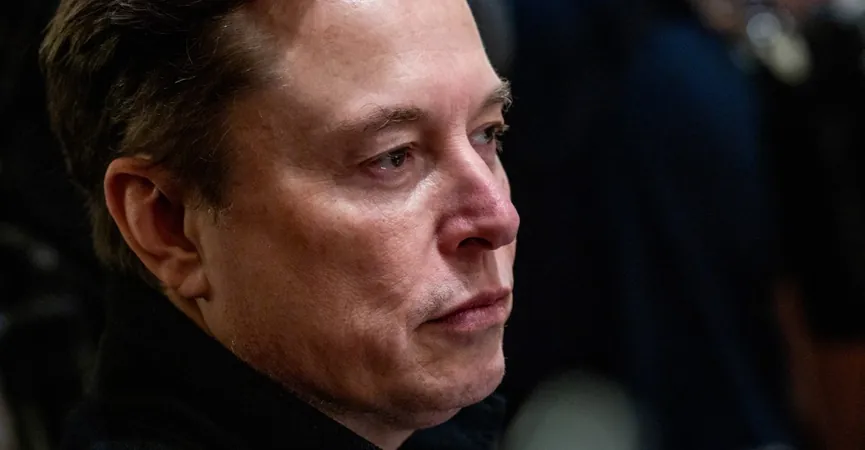
Why DOGE's Dreams Crumbled: The Surprising Truth Behind Its Downfall
2025-04-29
Author: Ying
Elon Musk's Ambitious Government Role Comes to a Steep Decline
Elon Musk, once riding high on his vision to revolutionize the federal government, is now scaling back his presence in Washington, leaving behind a tangled web of unfinished ambitions and significant chaos. His announcement to cut his White House work to just one or two days a week marks a sharp retreat from the audacious plans he had to overhaul federal spending and efficiency.
Inside the Rise and Fall of DOGE
The narrative of DOGE’s failure is as captivating as it is simple. Musk's goal to slash $1 trillion in government spending seemed utterly unattainable from the start, and it quickly became evident that he wouldn't even come close. But the ambition of DOGE wasn’t just about budget cuts; it represented Musk's vision of wielding executive power as if he were CEO of the entire federal government, driving a revolution within the bureaucracy.
Musk's Initial Power Grab: A CEO in the White House?
For a brief period during the early weeks of Trump’s presidency, Musk appeared to embody the role of a CEO embedded in the White House. Supported by tech-savvy allies, he had the reins to initiate dramatic changes, firing personnel and scrapping contracts with unprecedented speed. The plan was to run the government like one of his successful startups, yet after a robust opening, reality cut in.
The Cabinet Strikes Back: Musk’s Overreach Leads to Complications
Musk’s unchecked power rapidly collided with the realities of Washington. Much of his proposed agenda faced pushback from Trump’s Cabinet, which found their voices when they were finally confirmed. In a decisive meeting, they confronted Musk, objecting to his drastic cuts and asserting their authority over their departments, effectively sidelining him.
A Legacy of Disruption: The Unintended Consequences
The long-term impacts of Musk’s high-stakes maneuvers could be significant. The dismantling of key agencies, including the Consumer Financial Protection Bureau and USAID, raises questions about the future of government support for citizens and foreign assistance.
Looking Ahead: What’s Next for the DOGE Agenda?
As Musk retreats, the ideals of DOGE—reducing the federal workforce and centralizing power—are likely to linger, with other figures taking up the mantle. Cabinet secretaries, while taking back control, are also beginning to push their own reorganization plans, potentially leading to further layoffs and agency closures.
Lessons in Failure and Possible Future Reboots
Despite the chaos, there are lessons to be learned from DOGE's downfall. A future leader might revisit Musk's approach, learning from his missteps to implement a better version of governmental reform. As history has shown, the winds of change can shift quickly, and the specter of Musk’s return could loom once more in the halls of power.
Conclusion: A Failed Vision or an Opportunity for Growth?
While Musk's grand ambitions for DOGE seem to have disintegrated, the dialogue around government efficiency and restructuring will continue. His experiment may have ended poorly, but it opens a path for eventually reimagining governmental roles and responsibilities in line with modern expectations. As the spotlight dims on Musk, the potential for new actors to chart a different course remains.


 Brasil (PT)
Brasil (PT)
 Canada (EN)
Canada (EN)
 Chile (ES)
Chile (ES)
 Česko (CS)
Česko (CS)
 대한민국 (KO)
대한민국 (KO)
 España (ES)
España (ES)
 France (FR)
France (FR)
 Hong Kong (EN)
Hong Kong (EN)
 Italia (IT)
Italia (IT)
 日本 (JA)
日本 (JA)
 Magyarország (HU)
Magyarország (HU)
 Norge (NO)
Norge (NO)
 Polska (PL)
Polska (PL)
 Schweiz (DE)
Schweiz (DE)
 Singapore (EN)
Singapore (EN)
 Sverige (SV)
Sverige (SV)
 Suomi (FI)
Suomi (FI)
 Türkiye (TR)
Türkiye (TR)
 الإمارات العربية المتحدة (AR)
الإمارات العربية المتحدة (AR)